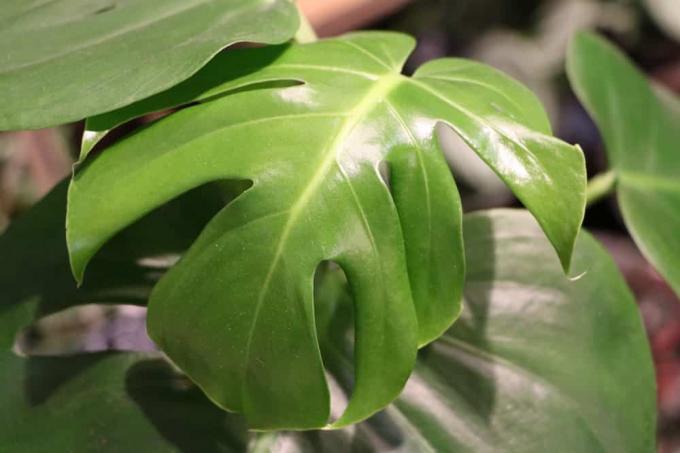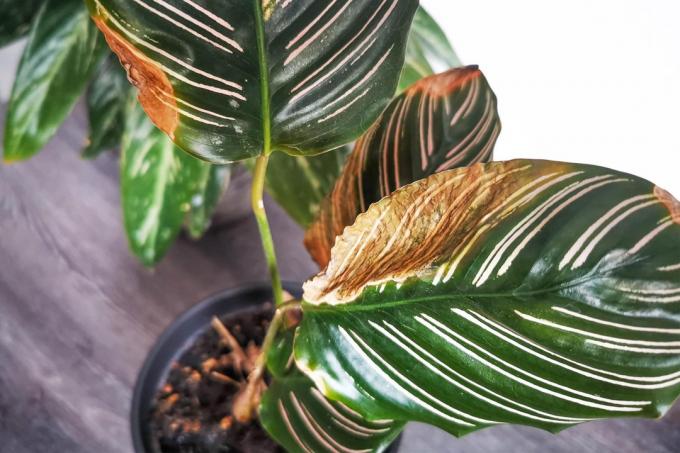

Table of contents
- head cuttings
- stem cuttings
- breeding pot
- moss
- care & timing
The window leaf bears the botanical name Monstera deliciosa and has established itself as a popular houseplant in this country. Therefore, there is often a desire for more plants, which can be propagated quickly and easily with offshoots. The plant forms pronounced aerial roots, which are very long. In addition, the large and partially openwork leaf structures are extremely eye-catching and give the window leaf an unmistakable touch.
head cuttings
The use of head cuttings is a quick and easy way to propagate the window leaf with offshoots. Since this is a vegetative reproduction, single-variety young plants grow afterwards. In order for the head cutting to successfully put down new roots, a suitable offshoot must be selected and the cut must be carried out carefully. If bruises and injuries occur, both the mother plant and the cutting suffer.
- Adequate cuttings must already have developed 2 leaves and 2 aerial roots
- Cut off offshoots with a sharp and disinfected cutting tool
- cut approx. Start 0.5-1.0 cm below the aerial root
- Allow interface to dry for at least 1 hour
- Only use fresh offshoots for propagation
- Place offshoots in a container together with aerial roots
- Gently press down the plant substrate
stem cuttings
If stem cuttings are used as offshoots from the window leaf, then individual pieces of the stem of the plant are used. Several cuttings can be used at the same time for propagation. Certain parts of the shoot axis that are not yet lignified are referred to as stem cuttings. The required areas of the monstera should not yet have any leaves, but should contain several and previously dormant leaf buds. The so-called vegetation points are important for successful propagation with this method. The pieces required for this are cut off the trunk at the correct height, with the size of the piece of trunk determining the subsequent quantity of stem cuttings. The rearing of the stem cuttings is relatively uncomplicated if the cut is made correctly. Within a few weeks, both new roots and leaves will develop from the dormant buds.
- Cut off the trunk between two still dormant buds
- Then divide larger trunk segment into smaller pieces
- Each section must have some vegetation points
- Lay individual stem pieces straight on the potting soil
- Then press lightly
- Vegetation points must face up
breeding pot
In order to successfully multiply the offshoots of the Monstera, suitable growing pots are required, which are filled with a growing substrate. If several cuttings were taken at the same time, then each of them should be placed in a separate container. To support rooting, it is advisable to erect a transparent hood over the offshoot. In the beginning, the right care measures are very important so that the young plants can develop healthily. If the rooting of the offshoots was successful, then the small window leaf forms new shoots. At this point, the cover must be completely removed and the seedling cared for as you would an adult specimen.
- A mixture of soil and sand is ideal
- Alternatively substrate with coconut fibers possible
- Cover with cling film or clear plastic bag
- Set up wooden sticks as spacers
- Foil must not touch leaves
- Place in a partially shaded window seat
- Pay attention to warm but not too hot temperature values
- Avoid direct sunlight and midday heat
- Keep the potting soil slightly moist without interruption
- Water only with lime-free water or rainwater
Tip:
The cover should be removed for a short period of time in between so that the offshoot is ventilated. Otherwise, the lack of ventilation supports the emergence of harmful mold.
moss

Another method for propagating the window leaf with offshoots is mossing, a gardening term. With this method, the bark is cut at a specific point on the trunk, alternatively a cut on the main shoot is also possible. Afterwards, the interface must be permanently prevented from closing. However, it may take some time for sufficient roots to develop at the interface. Rooting usually takes place after a few weeks or, in extreme cases, even after months. When the time comes, the targeted area below the cutting point is cut off from the mother plant. Immediately afterwards, the offshoot can be planted as usual.
- Start the cut below the leaf knot
- Pinch the interface with a small wooden stick
- Matches can also be used
- Cover the interface with absorbent material
- Moist soil or peat moss is ideal
- Then carefully wrap with foil
- Close the foil tightly at the top and bottom
- Keep the material under the film moist at all times
care & timing
The best time to propagate Monstera by cuttings is at the beginning of the growing season. During this phase, the Monstera starts growing again after the hibernation, so that leaves and roots can develop quickly in the offshoot. Propagation through head and stem cuttings can be carried out at the same time as pruning the plant. The evergreen plant originally comes from the tropical forests of the Caribbean and South America. There it grows below the large trees and is therefore used to partially shaded site conditions. For this reason, the window leaf cannot cope with blazing sunlight and strong midday heat. In addition, the plant is dependent on high humidity. As a climbing plant, Monstera grows quickly and therefore needs sufficient space at the top. Due to its growth form, the window leaf forms quite flexible aerial roots. Despite the flexible properties, the aerial roots can easily break off.
- Propagation by offshoots in spring is ideal
- Can be grown in a planter
- Aerial roots must be covered with soil
- Alternatively, offshoots can also root in the water glass
- Aerial roots must then be in the water
- Then plant directly
- Plant is happy about additional support in the pot
- Leaves need a lot of moisture
- The use of rainwater is optimal
- Handle aerial roots with care to prevent snapping
Tip:
Dust offshoots and newly grown young plants from a short distance with lime-free water from a spray bottle. In addition, wet the leaves individually with a slightly damp sponge.
 Home editorial office
Home editorial office
Learn more about houseplants

16 cat-friendly houseplants
If you share an apartment with a cat, you should not have any poisonous indoor plants, because cats occasionally eat the greenery. There are many cat-friendly houseplants that are harmless and can recover quickly once a cat has bitten them.

Calathea gets brown leaves: how to save?
The foliage of a calathea, also known as a basket marante, has its price. And that doesn't mean the purchase price. The tropical plant wants to be cared for and feels like it is in its native rainforest. She expresses her dissatisfaction with unfavorable living conditions with brown leaves.

Monstera droops leaves: what to do?
Its serrated leaves make the Monstera one of the most popular indoor plants. But what can be the reason for it letting the leaves droop, and what can you do about it?

Water houseplants properly 15 tips for potted plants
Watering indoor plants properly sometimes turns out to be more difficult than expected. There are certain points you need to keep in mind when watering your indoor plants so they can show off their full glory. 15 tips on the subject can be found in this guide.

Efeutute, Epipremnum aureum: care from A - Z
The ivy or Epipremnum aureum is one of the most popular houseplants par excellence and is also ideal for people without a green thumb. You can find out how to care for the plant from A - Z here.

Christmas Cactus Losing Buds: 6 Reasons & Solutions
The Christmas cactus is a real feast for the eyes in the living room from late summer with its beautiful flowers. Unfortunately, it often happens that the houseplant loses its buds. Find out here what causes the buds to fall and how you can counteract them.



